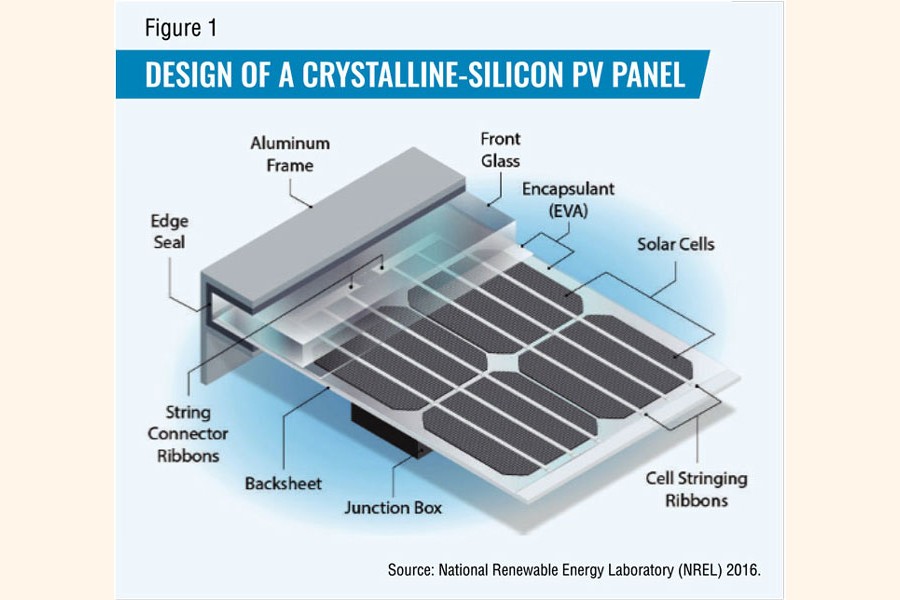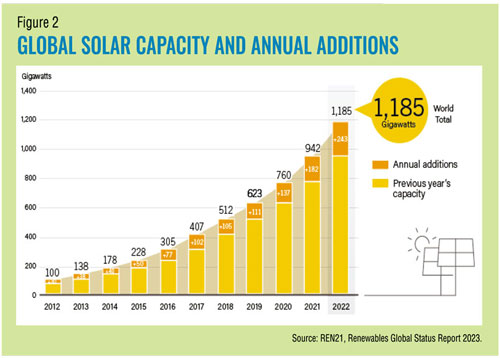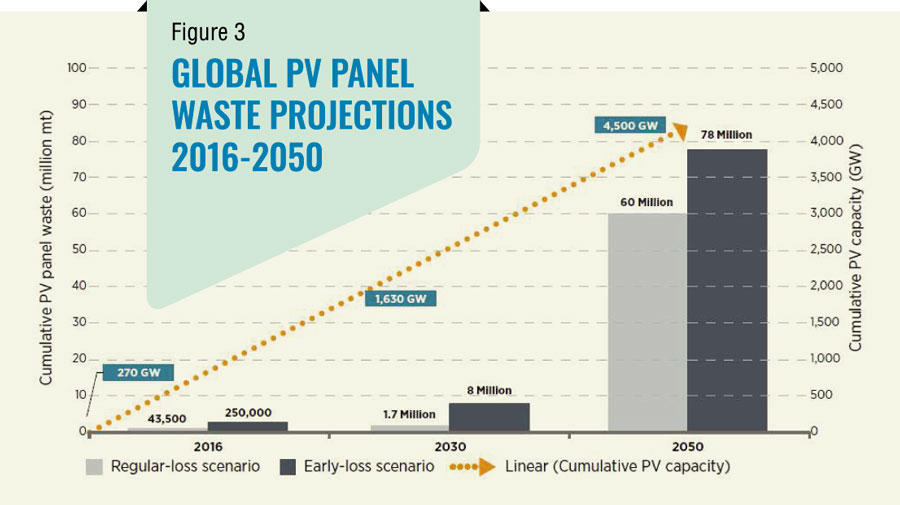
End-of-life management of solar power systems
An environmental imperative
Mohammad Alauddin | Sunday, 10 November 2024

 Solar energy stands as the planet's most abundant energy resource, offering an endless supply of renewable power to humanity. Of all renewable energy sources, the inexhaustible solar one is the most dispersed form of energy that can be captured and transformed into heat or electricity. The technology for this transformation comes in two primary forms: solar photovoltaics (PV) and solar thermal or concentrating solar power (CSP).
Solar energy stands as the planet's most abundant energy resource, offering an endless supply of renewable power to humanity. Of all renewable energy sources, the inexhaustible solar one is the most dispersed form of energy that can be captured and transformed into heat or electricity. The technology for this transformation comes in two primary forms: solar photovoltaics (PV) and solar thermal or concentrating solar power (CSP).
Solar PV directly converts sunlight into electricity and therefore avoids fossil-fuel consumption and greenhouse gas (GHG) emissions during operation. Currently, crystalline silicon (c-Si) solar PV panels, also known as modules, dominate the global solar PV installations. They follow a basic design pattern. (Figure 1)
The C-Si solar PV panels are primarily composed of glass, which makes up about 76 per cent of their weight, forming the panel surface. Additionally, they contain 10-percent polymer (used in the encapsulant and back-sheet foil), 8.0-percent aluminum (found mostly in the frame), and 5.0-percent silicon, the core material in solar cells. The design is completed with 1.0-percent copper for interconnectors and a small fraction (less than 0.1%) of silver for contact lines, along with trace amounts of other metals like tin and lead. But that's not all - a solar-power system also integrates other key components, such as inverters, racking and, sometimes, a battery-backup system.
Solar PV technology has been embraced worldwide thanks to its ease of implementation and cost-effectiveness. Driven by technological innovations, declining costs and rising concerns over fossil fuels, the deployment of solar PV has skyrocketed since the early 2000s. By 2022, the global installed capacity of solar PV had reached1185 gigawatts (GW), representing 70% of all new renewable-power-capacity additions (Figure 2). As the deployment of global solar PV continues to climb, there's a corresponding rise in the volume of solar PV panels reaching the end of their life. It's expected that significant amounts of waste will emerge annually in the near future. Typically, solar PV panels have a lifespan of 20-30 years. The International Renewable Energy Agency (IRENA) and the International Energy Agency Photovoltaic Power Systems(IEA-PVPS) have projected future PV -panel-waste volumes up to 2050. Their projections are based on two scenarios: 'regular-loss', which assumes a 30-year lifespan with no premature failures, and 'early-loss', which factors in failures occurring before the 30-year mark, including 'infant', 'mid-life', and 'wear-out' incidents. These projections are detailed in Figure 3.
As the deployment of global solar PV continues to climb, there's a corresponding rise in the volume of solar PV panels reaching the end of their life. It's expected that significant amounts of waste will emerge annually in the near future. Typically, solar PV panels have a lifespan of 20-30 years. The International Renewable Energy Agency (IRENA) and the International Energy Agency Photovoltaic Power Systems(IEA-PVPS) have projected future PV -panel-waste volumes up to 2050. Their projections are based on two scenarios: 'regular-loss', which assumes a 30-year lifespan with no premature failures, and 'early-loss', which factors in failures occurring before the 30-year mark, including 'infant', 'mid-life', and 'wear-out' incidents. These projections are detailed in Figure 3. By 2030 and 2050, it's projected that the cumulative mass of end-of-life PV panels worldwide will reach staggering amounts of 8 million tones and 78 million tones, respectively. This growing volume of PV-panel wastes poses a significant environmental challenge as they comprise various hazardous materials, including silicon, silver, indium, gallium, selenium, cadmium, tellurium, tin, and lead.
By 2030 and 2050, it's projected that the cumulative mass of end-of-life PV panels worldwide will reach staggering amounts of 8 million tones and 78 million tones, respectively. This growing volume of PV-panel wastes poses a significant environmental challenge as they comprise various hazardous materials, including silicon, silver, indium, gallium, selenium, cadmium, tellurium, tin, and lead.
Bangladesh embarked on its solar -power journey in 1993, with the Bangladesh Rural Electrification Board (BREB) installing the first Solar Home System (SHS) under the France-aided Rural Electrification and Renewable Energy Development (RERED) project. Following the successful completion of the RERED project, Infrastructure Development Company Limited (IDCOL) initiated its SHS programme in 2003, aiming to meet the basic electricity needs of off-grid rural communities and support government's goal of universal electricity access. IDCOL's SHS programme has gained international recognition as the largest off-grid electrification scheme in the world.
With IDCOL's efforts, over 4.1 million SHSs have been financed and installed in rural off-grid areas of Bangladesh, with additional installations by various organisations, bringing the total to approximately 6.0 million SHSs. Besides SHSs, IDCOL has also spearheaded the installation of 26 solar mini-grids in remote areas, delivering grid-quality electricity to more than 20,000 households and businesses, totaling about 5MW in capacity. As of December 2022, IDCOL's financing programme has brought 1,523 solar irrigation pumps into operation, benefiting over 65,000 farmers.
In view of land scarcity, the Bangladesh government has focused on rooftop solar solutions, introducing a net energy-metering scheme, to foster this approach. Currently, the combined capacity of rooftop solar systems is 40 MWs. With plans to develop 100 economic zones by 2035, the government envisions these zones as potential hosts for approximately 10GW industrial rooftop solar power.
The current global energy crisis underscores the importance of transitioning to renewable energy, both to reduce import costs and to lessen the climate impact of fossil fuels. At the 26th United Nations Climate Conference (CoP26), a target was set to generate 40 per cent of the country's power from renewables by 2041 by the previous government. In line with this vision, the previous government initiated several utility-scale solar-power-plant projects, boosting renewable power generation.
At present, the aggregated capacity of solar PV installations in Bangladesh, including both on-grid and off-grid applications, is nearing 1GW, with additional projects of about 1GW awaiting government approval.
However, as large-scale solar PV deployment increases, Bangladesh faces the emerging challenge of managing end-of-life solar PV panels and components. While the Department of Environment (DoE) issued the Hazardous Waste (e-waste) Management Rules in 2021, these don't specifically address solar-PV waste. Unlike the European Union (EU), which mandates the collection and recycling of end-of-life solar PV panels, Bangladesh lacks similar regulations. Consequently, a significant amount of stand-alone SHSs and their accessories are being discarded improperly, raising environmental concerns. Currently, there is no empirical data on the cumulative mass of end-of-life solar-PV systems in Bangladesh, nor projections for 2030 and 2050.
Solar systems installed in the late 1990s and early 2000s are nearing their end-of-life stages, contributing to a growing e-waste problem. Despite their long service life of 25-30 years, the disposal of solar panels can have detrimental environmental impacts. In contrast, EU countries have adopted the extended-producer-responsibility (EPR) principle, which holds producers accountable for their products' environmental impact up to end of life. Germany, for instance, boasts dedicated crystalline-silicon (Ci-Si) PV-recycling facilities, such as Fast Solar, that recycle up to 90% of semiconductor material and glass.
In Bangladesh, however, there is no dedicated authority for managing solar-panel end-of-life and-related e-waste. Therefore, establishing recycling facilities and considering end-of-life management for solar-PV panels in Bangladesh is imperative. It will not only enable the reuse of solar PV materials but also foster a circular economy.
The writer is Rector, Bangladesh Power Management Institute.
mohammad_alauddin4124@yahoo.com